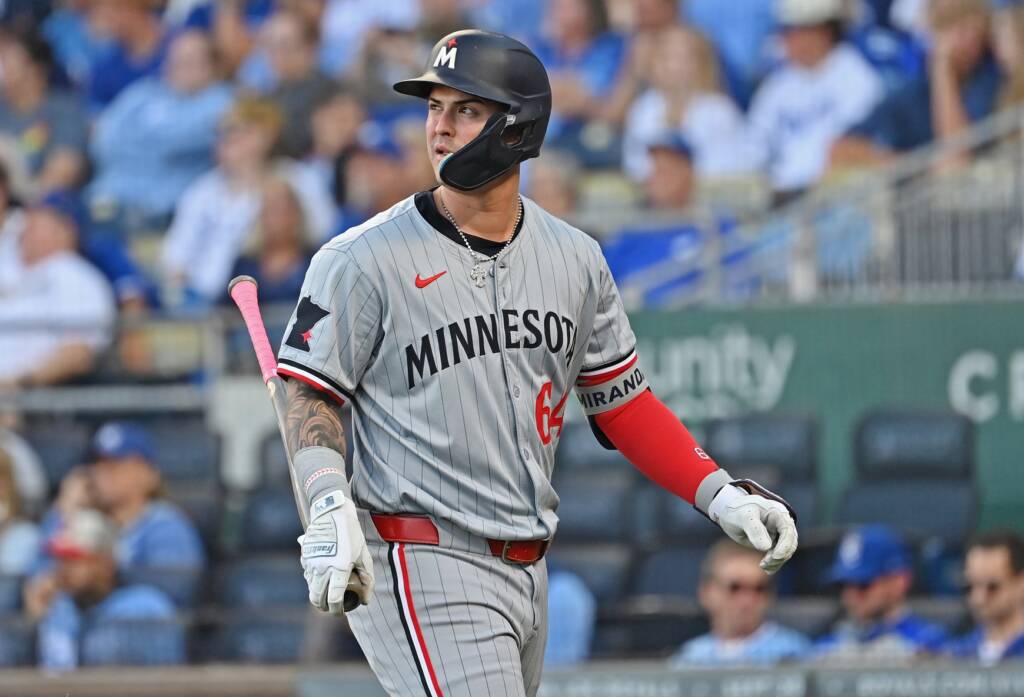The Minnesota Twins got impressive play from their star hitters in the first half, but multiple second-tier players stepped up and delivered from the beginning of the season through the All-Star break in mid-July. Make no mistake, Carlos Correa and Byron Buxton were major parts of the team’s success. However, young players trying to earn a full-time role with the club were the engine that kept this team trucking for three-plus months.
But now that the lineup appears to be running on fumes at the worst possible time, many are wondering what happened to this little engine that could. Whether it’s playing through legitimate injuries or the players wearing down near the end of a long season, José Miranda, Ryan Jeffers, and Willi Castro haven’t been the same in the second half. The Twins will need them to rediscover their early success if they hope to make a meaningful postseason push.
The Twins will also hope to get a rebound from star third baseman Royce Lewis, but he only played 23 games in the first half, so I left him off this list. They’ll also want to keep Matt Wallner healthy and productive. However, because he spent most of the first three months of the season in Triple-A, I’ve also omitted him.
Jose Miranda
The 26-year-old infielder wasn’t a focal point of the big league team out of spring training, but he soon became an essential part of their offense. Miranda had a triple slash of .325/.366/.522 in the first half of the season, which was 49% better than the league average, according to wRC+. He was a legitimate meat-of-the-order stalwart while playing solid, if unspectacular, defense between first base and third as a primary fill-in when Lewis went on the IL two innings into the regular season.
Not only was Miranda healthy, productive, and powerful, but he also fit seamlessly into the game plan that Rocco Baldelli and his staff had in place. That meant a ton of platoon splits and pinch-hit opportunities in critical spots during the first half of the games. It was common to see Baldelli start Miranda against left-handed starters, then remove him for someone like Trevor Larnach or Alex Kirilloff midgame. Miranda could also start games on the bench and then come in later for a lighter hitter, such as Manuel Margot, in clutch opportunities.
However, Miranda’s production has dipped considerably in the second half, especially after returning from an IL stint in July. Since the All-Star break, Miranda is hitting just .235/.266/.333, which is 39% below league average. His decrease in power is especially concerning. Since All-Star weekend, Miranda only has ten extra-base hits with zero home runs.
Ryan Jeffers
It’s hard to call out a catcher for their diminished offensive production, especially in the second half of a long season in which they’ve played more than half of the team’s games. A 162-game season is long and daunting, especially for backstops. Still, it feels like a lifetime since we’ve seen peak Jeffers. While his numbers over the last two months aren’t abysmal, they show a significant dip for the 27-year-old.
In the first half, Jeffers looked like a potential All-Star. He hit .237/.334/.467, including a rough three-week stretch leading into the break. Jeffers was popping home runs, driving in runs during important pivot points of many games, and even filled in as designated hitter on many of his days off from catching.
However, Jeffers’ on-base percentage is down about 60 points since July 15th, and he isn’t drawing as many walks. Even more concerning may be what appears to be a near abandonment of trying to control the running game for opponents, especially later in games.
The Twins will want him to regain their trust at the dish and behind it as their primary backstop going into the postseason.
Willi Castro
It feels crazy to think that Castro has been a centerpiece of this lineup for much of the season, especially after a brutal start to his 2024 campaign, where he had a .158 batting average through his first 20 games. However, he turned things around quickly enough that he was named one of the club’s two All-Stars alongside Correa.
In the first half of the season, Castro played every game and hit a very strong .265/.352/.422. That performance was roughly 23% better than league average and was invaluable for a team that had to plug him into six different defensive positions. He was an enigma, and it appeared that the front office had found a diamond in the rough when they brought him in on a minor league deal heading into 2023.
But Castro has been rather dreadful at the plate since playing in his first All-Star game, with a strikeout rate that has completely ballooned to a concerning 28.9%.
Like Miranda and Jeffers, the Twins will desperately want Castro to rediscover what made him so brilliant in the first half. Not only was he a standout player, but he also filled in wherever the club asked. Based on the overall health of their current roster, they will almost certainly have that same need.

